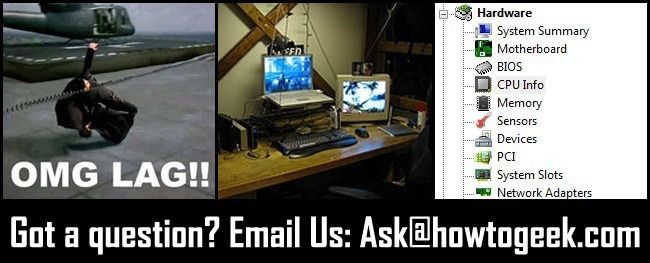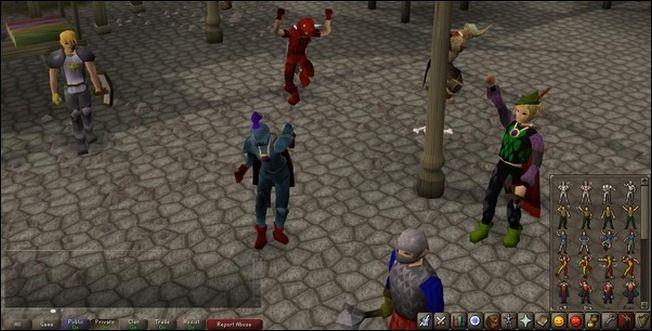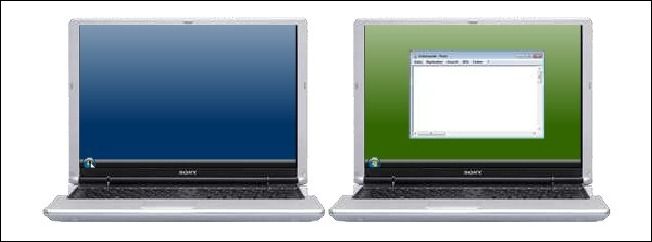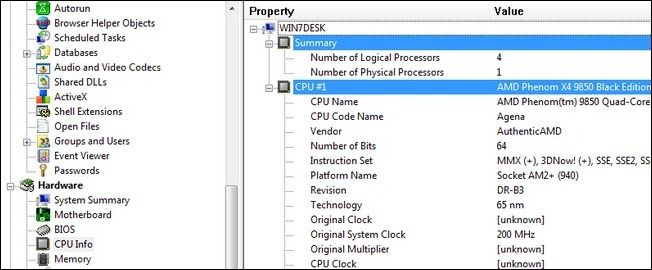Quick Links
You’ve got questions and we’ve got answers. This week we take a look at data latency while playing computer games, how to use your laptop screen as a secondary monitor, and how to easily list and ID the components in your Windows machine.
Understanding Data Latency and Gaming
Dear How-To Geek,
My daughter loves a game called Runescape (which I use to blackmail her into getting her homework done). She plays this game on a dial-up account because she says the Wildblue satellite internet account has a big lag to it. I have sort of verified this by watching when she clicks on the screen and watched her Runescape character move when she connects on dial-up and Wildblue. Wildblue is definitely slower. Yet, when we download on dial-up, dial-up is insanely slower.
This doesn’t make sense to me. How can satellite internet be so much faster downloading than dial-up, but yet be so much slower when playing a game on it?
Sincerely,
Watching Lag in Wisconsin
Dear Watching,
What's going on is this: there's a big difference between total bandwidth (the amount of data you can download at a time), and latency (how fast each back and forth happens). Satellite internet is notorious for very long latency, but obviously can transfer a lot of data (like all your TV channels).
Imagine it like this: if you lived in a big city, you can hire a bike-messenger courier (low latency) to very quickly deliver letters and small packages from one place to another. Alternatively, you could hire a big truck (high bandwidth) to carry larger loads—but it would take a lot longer to load up the truck and make your way through traffic. That's the difference between latency and total bandwidth.
Since online gaming requires a lot of quick back and forth, but not necessarily a lot of data, it's best to have low-latency connections in order to keep the responses between the game server and your computer snappy.
Using Your Laptop Screen as a Second Monitor
Dear HowToGeek,
I have heard that you can use a laptop as a second monitor for your desktop. Do you need another graphics card in the desktop or a special cord?
Sincerely,
Duel Screen
Dear Dual Screen,
You don’t need another graphics card or special cable—nor would you likely be able to find a cable as very few laptops have any sort of video-in capability—your best bet is to turn to a software solution. MaxiVista is a popular, but unfortunately not free, solution for Windows. It will set you back $40 but does come with a trial period. The application extends your desktop, over your network, to the screen of another computer (laptop or desktop). A less popular, but free, Windows solution is ZoneScreen. ScreenRecycle ($30) is an option for Mac and Windows users. To extend screens between Macs and between Mac and iOS devices such as the iPhone and iPad, check out Air Display ($20 and $10, respectively).
Identifying Windows Hardware Components
Dear How-To Geek,
Is there an easy way to see all the hardware components in my Windows desktop computer?
Sincerely,
Curiosity Killed the Cat
Dear Curiosity,
There are two simple ways you can check out the hardware in your machine without having to crack open the case. If you’re running Windows Vista or Windows 7 you can open the start menu and type “System Information” in the run box. If you want a more detailed view you can also download the freeware version of System Information for Windows (SIW)—scroll down to the bottom of the page to get to the free version. SIW will give you as intimate picture of your computer as you can get without pulling it apart and checking every serial number of every component.
Have a question you want to put before the How-To Geek staff? Shoot us an email at ask@howtogeek.com and then keep an eye out for a solution in the Ask How-To Geek column.




